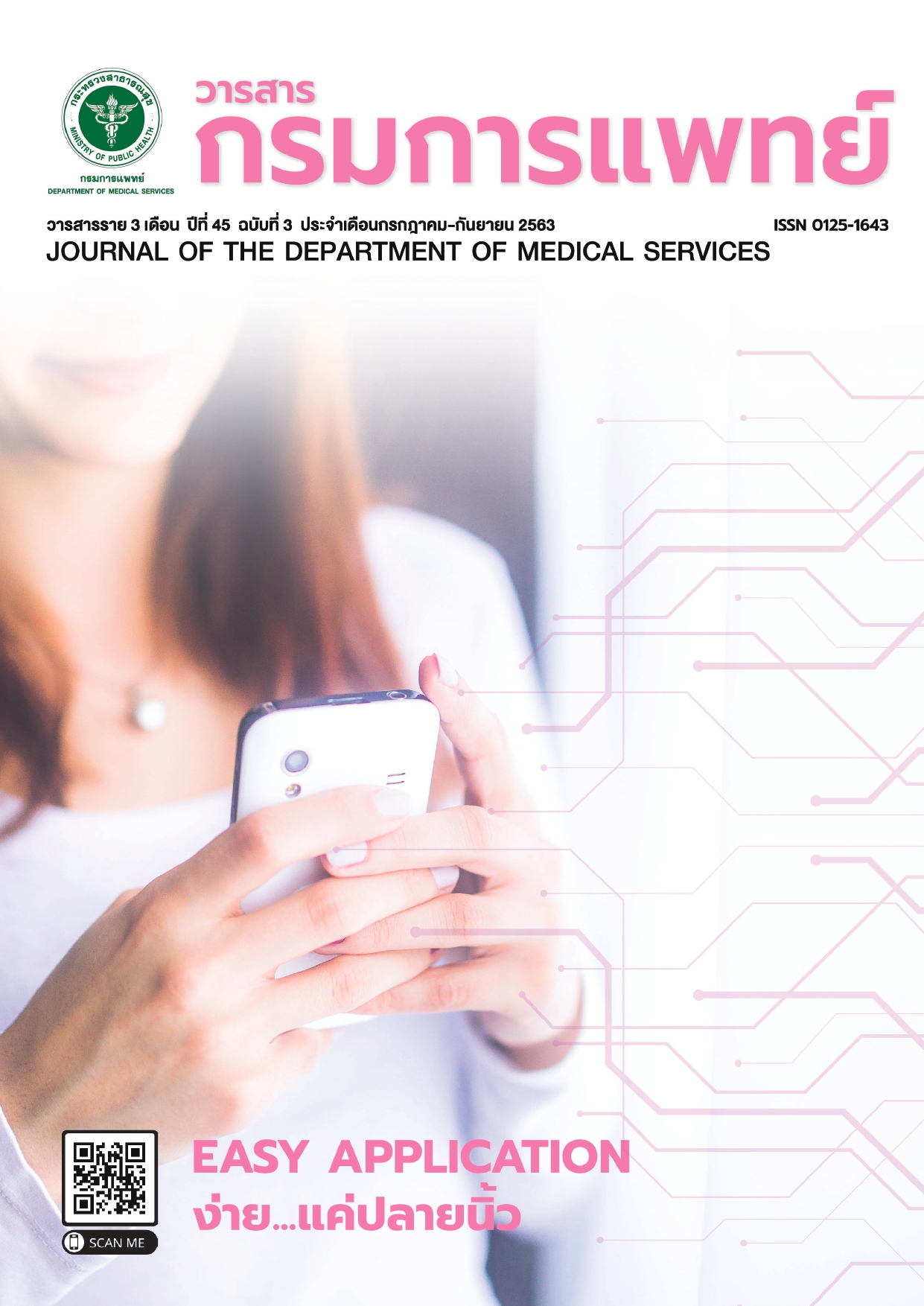Caries Risk Profile of Diabetes Mellitus Patients Using Cariogram in Sangkha Hospital, Surin Province
Keywords:
Caries risk, Cariogram, Diabetes mellitusAbstract
Background : Diabetes Mellitus (DM) is associated with periodontal disease but the relationship between diabetes mellitus and dental caries is controversy. The cariogram is the one tool of assessment caries risk.
Objective : To investigate caries risk profile of diabetes mellitus patients using cariogram in Sangkha Hospital, Surin Province.
Method : Data were collected from September to December 2018. The samples comprised 201 patients. Research team collected whole saliva samples, recorded the buffer capacity and salivary rate using questionnaire and oral examination forms in order to calculate risk according to the cariogram model. Caries-related variables were collected and inserted into the cariogram software to calculate the actual chance of avoiding caries.
Result : The study showed 75.1% of samples was female, 66.2% was age ≤ 60 yrs. 99.5% was type II diabetes mellitus. The duration of DM was more than 5 years 62.2%. Mean decay, missing and filling of permanent teeth (DMFT) was 8.99 teeth per person. Subjects who had FBS ≤ 130 mg/dl and FBS > 130 mg/dl, mean DMFT was 7.33 teeth per person and 9.66 teeth per person respectively. Those whose age < 60 and ≥ 60, mean DMFT was 8.56 teeth per person and 9.82 teeth per person respectively. Cariogram showed 84.58% of sample had high caries risk (chance to avoid new cavities 61 -100).
Conclusion : Diabetes mellitus patients using cariogram in Sangkha Hospital, Surin Province had high caries risk.
References
Health promition policy research center. Report of NCDs. International health policy Program; 2016.
Derojanawong C, Pourvilai K. Diagnosis and classification of diabetes. Diabetes texts. The endocrine society of thailand. Bangkok: Ruen kaew printing house; 2003: 2-14.
American Diabetes Association. Report of the expert committee on the diagnosis and classification of diabetes mellitus. Diabetes Car 1997;20:1187-97.
Report of the 8th National survey of the state of oral health in thailand 2017. Department of health, ministry of health; 2018.
Survey of oral health status and dental behavior in surin province 2017. Surin : Surin Public oral health; 2018.
Heymann H, Swift EJ, Ritter AV, Sturdevant CM. Sturdevant’s art and science of operative dentistry. St. Louis,Mo: Elsevier/ Mosby; 2013.
Iqbal S, Kazmi F, Asad SK. Dental caries and diabetes mellitus. Pakistan Oral & Dental Journal 2011;31.
Seethalakshmi C, Seethalakshmi C, Jagat RC. Salivary markers of diabetes mellitus and oral status. Journal of Clinical and Diagnostic Research 2016;10:ZC12-4.
Hintao J, Teanpaisan R, Chongsuvivatwong V, Ratarasan C, Dahlen G. The microbiological profiles of saliva, supragingival and subgingival plaque and dental caries in adults with and without type 2 diabetes mellitus. Oral Microbiol Immunol 2007;22:175–81.
Saensorn W, Chatchaiwiwatana S, Bumrerrach S. Dibestis and oral health. KDJ 2010:13.
Jones RB, McCallum RM, Kay EJ, Kirkin V, McDonald P. Oral health and oral health behaviour in a population of diabetic outpatient clinic attenders. Community Dent Oral Epidemiol 1992;20:204-7.
Bacic M, Ciglar I, Granic M, Plancak D, Sutalo J. Dental status in a group of adult diabetic patients. Community Dent Oral Epidemiol 1989;17:313-6.
Bratthall D, Hänsel Petersson G, Stjernswärd JR. CARIOGRAM MANUAL. Stockholm: Förlagshuset Gothia; 1997.
Larmas M. Simple tests for caries susceptibility. Int Dent J 1985; 35:109-17.
Celik EU, Gokay N, Ates M. Efficiency of caries risk assessment in young adults using Cariogram. Eur J Dent 2012; 6:270-9.
Rafatjou R, Razavi Z, Tayebi S, Khalili M, Farhadian M. Dental Health Status and Hygiene in Children and Adolescents with Type 1 Diabetes Mellitus. J Res Health Sci 2016; 16:122-6.
Miralles L, Silvestre FJ, Hernández-Mijares A, Bautista D, Llambes F, Grau D. Dental caries in type 1 diabetics: influence of systemic factors of the disease upon the development of dental caries. Med Oral Patol Oral Cir Bucal 2006; 11:E256-60.
Seethalaks C, Jagat Redd RC, Asifa N. Correlation of Salivary pH, Incidence of Dental Caries and Periodontal Status in Diabetes Mellitus Patients: A Cross-sectional Study. Journal of Clinical and Diagnostic Research 2016; 10:ZC12-14.
Al-Khayoun JD, Diab BS. Dental caries, Mutans Streptococci, Lactobacilli and salivary status of type1 diabetic mellitus patients aged 18-22 years in relation to Glycated Haemoglobin. Journal of Baghdad College of Dentistry 2013; 325:1-6.
Collin HL, Uusitupa M, Niskanen L, Koivisto AM, Markkanen H, Meurman JH. Caries in patients with non-insulindependent diabetes mellitus. Oral Surg Oral Med Oral Pathol Oral Radiol Endod 1998; 85:680-5.
Ruiz-Miravet A, Montiel-Company JM, Almerich-Silla JM. Evaluation of caries risk in a young adult population.Med Oral Patol Oral Cir Bucal 2007; 12:E412-8.
Ligtenberg AJ, de Soet JJ, Veerman EC, Amerongen AV. Oral diseases from detection to diagnostics. Ann NY Acad Sci 2007; 1098:200–3.
Downloads
Published
How to Cite
Issue
Section
License
บทความที่ได้รับการตีพิมพ์เป็นลิขสิทธิ์ของกรมการแพทย์ กระทรวงสาธารณสุข
ข้อความและข้อคิดเห็นต่างๆ เป็นของผู้เขียนบทความ ไม่ใช่ความเห็นของกองบรรณาธิการหรือของวารสารกรมการแพทย์



